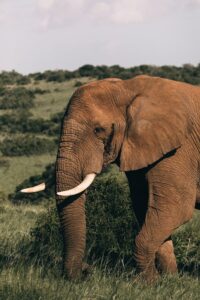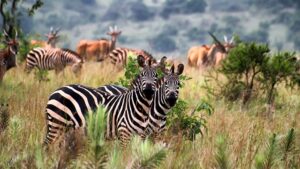The Masai Mara, a renowned wildlife reserve located in southwestern Kenya. It is one of the most famous and revered safari destinations in the world. This forms the northern extension of the Serengeti National Park in Tanzania. They creates a contiguous habitat for a vast array of wildlife. Spanning approximately 1,510 square kilometers, the reserve is named after the indigenous Maasai people and the Mara River. The Masai Mara‘s fame is attributed to several key factors, including its abundant wildlife, the Great Migration, cultural heritage, stunning landscapes, and conservation efforts. This essay delves into these aspects to provide a comprehensive understanding of what makes the Masai Mara a globally significant natural and cultural treasure.
Masai Mara is famous for Abundant Wildlife
One of the primary reasons the Masai Mara is so famous is its extraordinary wildlife population. The reserve is home to the “Big Five” lions, elephants, leopards, buffaloes, and rhinos that you will enjoy. This makes it a prime destination if you are looking to encounter these iconic species in their natural habitat. In addition to the Big Five, the Masai Mara will give you a chance to view an impressive diversity of other animals. these primates include cheetahs, hyenas, giraffes, zebras, wildebeests, hippos, crocodiles, and numerous antelope species.
The predator-prey dynamics in the Masai Mara are particularly fascinating. You can study about lion prides of the Masai Mara which provides invaluable insights into the behavior, social structure, and ecology of these majestic animals. Get to know about Cheetahs which are known for their incredible speed. These are often seen hunting in the open savannahs. Leopards, although more elusive, are frequently spotted lounging in trees or stealthily moving through the bush.
Masai Mara is famous for The Great Migration
The Great Migration is arguably the most famous wildlife event associated with the Masai Mara. It gives you a chance to witness this annual phenomenon that involves the movement of over 1.5 million wildebeests. They are accompanied by hundreds of thousands of zebras and gazelles, between the Serengeti in Tanzania and the Masai Mara in search of greener pastures. The migration is driven by seasonal rainfall patterns and the availability of fresh grazing grounds.
Typically occurring between July and October, you will witness vast herds cross the treacherous Mara River, where many fall prey to crocodiles and other predators. The dramatic spectacle of life and death will draw your attention. What of a sight of endless columns of animals stretching to the horizon, coupled with the thunderous sound of their hooves? That is a testament to the resilience and instinctual drive of these migratory species.
Masai Mara is famous for its Cultural Heritage
Masai Mara is also renowned for its rich cultural heritage, primarily due to the Masai people who inhabit the region. You will meet these people who are a semi-nomadic ethnic group. They are known for their distinctive customs, dress, and lifestyle. Their traditional red shukas (cloaks), beaded jeweler, and elaborate ceremonies are iconic symbols of African culture.
A visit to the Masai Mara will give you the opportunity to engage with the Masai community, learning about their traditions, beliefs, and way of life. Many tours include visits to Masai villages (manyattas). Where you can witness traditional dances, listen to stories, and even participate in cultural activities. The Masai’s deep connection to the land and their knowledge of local wildlife make them invaluable guides and stewards of the region’s natural resources.
Stunning Landscapes
The landscapes of the Masai Mara are as breathtaking as its wildlife. The reserve is characterized by vast open plains dotted with acacia trees, rolling hills, and the meandering Mara and Talek rivers. This diverse topography provides a stunning backdrop for wildlife viewing and photography.
The golden savannahs, particularly during sunrise and sunset, offer some of the most picturesque vistas in Africa. The expansive skies, dramatic cloud formations, and vibrant hues of the landscape create a surreal and awe-inspiring environment. This natural beauty is not only a feast for the eyes but also serves as an essential habitat for the reserve’s diverse flora and fauna. You will surely enjoy!
Research and Education
The Masai Mara is a hub for wildlife research and education. Numerous scientific studies are conducted in the reserve, focusing on topics such as animal behavior, ecology, and conservation. Research institutions and conservation organizations collaborate to gather data, monitor wildlife populations, and develop strategies for sustainable management.
Educational programs and outreach initiatives are also integral to the Masai Mara’s conservation efforts. Schools, universities, and community groups often participate in field trips and workshops to learn about it. By fostering a deeper understanding and appreciation of the natural world, these programs aim to inspire the next generation of conservationists and advocates.
Tourism and Economic Impact
Tourism is a major driver of the Masai Mara ‘s economy. It provides livelihoods for many local people and generating revenue for conservation efforts. We offer a range of safari experiences, from luxury lodges and tented camps to budget-friendly options. Game drives, guided walks, hot air balloon safaris, and cultural tours are among the popular activities that you will enjoy.
The economic benefits of tourism extend beyond direct employment in the hospitality industry. Local artisans and craftspeople sell traditional Maasai jewelry, clothing, and artwork to tourists. While farmers and producers supply food and goods to lodges and camps. The revenue generated from tourism helps fund community development projects, education, healthcare, and infrastructure improvements.
Conclusion:
The Masai Mara ‘s fame is well-deserved, rooted in its incredible wildlife, the awe-inspiring Great Migration, rich cultural heritage, stunning landscapes, and robust conservation efforts. This unique combination of natural and cultural elements creates a destination that captivates the hearts and minds of all who visit. The reserve’s success in balancing conservation with community needs serves as a model for sustainable wildlife management.



